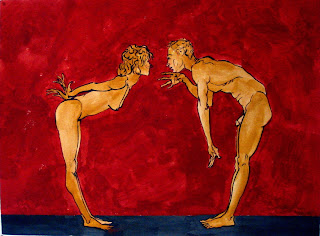 If you have taken a class with me in the last five years then you will remember "passages" or you really had some substance help you forget. After giving my "painting as process" tour tonight at the Met to a few private students, I am very heightened to the fact that the artists
If you have taken a class with me in the last five years then you will remember "passages" or you really had some substance help you forget. After giving my "painting as process" tour tonight at the Met to a few private students, I am very heightened to the fact that the artists from at least the 15th century have found the surface and form of the elements of the picture, people, plants, cats, Jesus, etc. to be worthy of depiction (showing). The space around the elements become a factor of unity, literally, physically painted or drawn to link all the elements. So consider drawing the surface and direction of the form you are depicting in a tangible way.
This generalized depiction, from a model, shows the torso in two views from the hip. It emphasizes the combination of lines in length with lines around. So a passage is a channel, a way through and not a style. Voyage, path, progress, change; a few more definitions of passage. All are pertinent to the practice.








